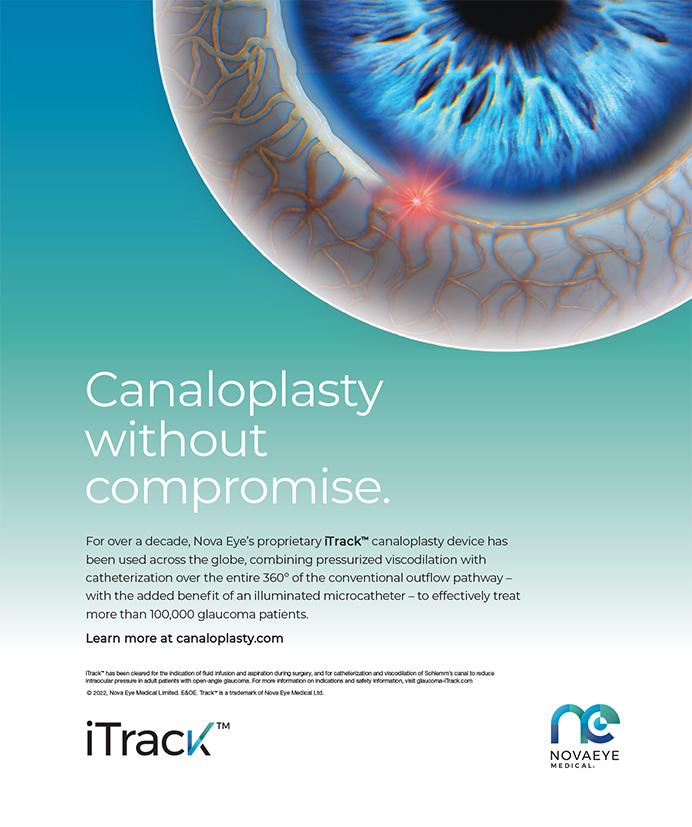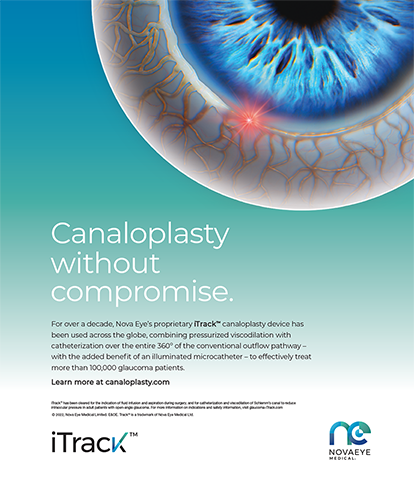Cover Stories | Oct 2005
Lamellar Keratorefractive Surgery
How do you identify candidates for this procedure?
Lee T. Nordan, MD
As stated in last month's column, I had planned to discuss further details about a Snellen contrast acuity test on which Rick Baker, OD, and I have been working. There is an overwhelming need for a Snellen contrast test to be used as a routine method of testing visual function for patients who have undergone any form of refractive surgery or are suspected of having a cataract or macular disease. As important as I believe this topic of contrast acuity testing is, however, another even more important issue—avoiding corneal ectasia after keratorefractive surgery—overshadows it.
Perhaps reports of problems of lamellar keratorefractive surgery performed on keratoconic corneas are based on an old procedure performed many years ago that has ceased being used in the past several years. Let us hope so. Just in case some surgeons have not seen the stop sign yet, I would like to review my experiences during the last 25 years with respect to lamellar keratorefractive surgery and the abnormal cornea.
PREOPERATIVE CORNEAL EXAMiination
Methods
How can the surgeon determine preoperatively if a clear cornea that appears normal at the slit lamp is abnormal? Automated topography, manual keratometry, and corneal pachymetry are the most likely methods. Identifying an abnormal cornea is a difficult problem, because we surgeons are searching for a cornea that has less stromal strength than usual but that might be functioning normally (until it is weakened by lamellar keratorefractive surgery). In other words, a cornea without irregular astigmatism has a certain degree of reserve that will keep it regular until the IOP exceeds the capability of the corneal stroma to maintain a perfect optical surface.
Automated Topography
In recent years, automated topography has shown us early signs of corneal peripheral marginal degeneration, which is probably a variant of keratoconus. Both conditions involve a noninflammatory weakening of the stroma, although only keratoconus usually manifests itself inferocentrally, and corneal peripheral marginal degeneration more peripherally. The point is, if an automated topography shows a mildly abnormal cornea, the surgeon should consider this cornea as preweakened, even in the face of regular central mires and/or 20/20 BCVA. Further weakening of this cornea is likely to result in ectasia.
Manual Topography
Manual topography is more sensitive than automated topography, but it requires a skilled observer. Any uncertain results of automated topography should be reviewed using manual keratometry performed by the surgeon. In my experience, every irregularity determined by automated topography will be reflected in manual topography.
Corneal Pachymetry
Corneal pachymetry is valuable only if the surgeon chooses a corneal thickness considered abnormal, even in the face of a regular central cornea. Remember, we are trying to predict those corneas that will become ectatic after they are weakened. My prediction is 505µm for the central cornea or an inferocentral corneal thickness at a 7-mm optical zone that is not thicker than the central cornea. It is a good idea to measure the central cornea and the four quadrants of the 7-mm optical zone as well.
In my opinion, there is probably room for some (very little) debate about the crucial corneal thickness, but 500µm and less is clearly outside of three standard deviation units from the norm and is clearly abnormal.
Developing strict rules about lamellar keratorefractive surgery will prevent the vast majority of corneal ectasia cases that follow lamellar refractive surgery.
GOOD NEWS
The good news is that PRK does not (in my experience) cause corneal ectasia, even when performed on mild cases of frank keratoconus. I personally performed PRK with up to 12 years of follow-up on approximately 500 patients who were at least 30 years old and had mild keratoconus. I defined mild keratoconus as a visual acuity no worse than 20/40+ preoperatively with spectacles. I noted no worsening of the keratoconus. As an aside, the central corneal opacity that forms as a result of keratoconus patients' wearing hard contact lenses can be removed by debriding the epithelium with a blade along with similarly debriding the underlying fibrotic material that resides anterior to Bowman's membrane.
In more than 2,500 cases of keratomileusis observed from 1979 to 1995, ectasia occurred in the long-term postoperative eyes that only had a preoperative refraction of -14.00D or greater. The routine corneal flap was 320µm in keratomileusis, but these high myopes required a 380-µm corneal flap. Therefore, in my opinion, a residual central corneal thickness of 200µm (range, 520 to 320µm) in a normal cornea does not lead to ectasia. I am not advocating 300-µm flaps, but rather I am noting a measure of comfort when creating 120-µm thick flaps in a cornea of normal stromal strength.
I have little faith that intraoperative subtraction pachymetry is very accurate for determining flap thickness. A thickness-measuring device that calculated corneal thickness by contacting the flap on both sides determined the flap thickness during keratomileusis. In vivo measurement (photography or improved ultrasound) will probably be the most accurate manner of determining true corneal flap thickness so that factors such as the effect of loss of endothelial cells can be eliminated.
CLINICAL SUMMARY
If a clear cornea shows corneal irregular astigmatism preoperatively, it is already too weak to undergo lamellar surgery, because any further weakening of the cornea will certainly create more irregularity. If a cornea is too thin, it is likely to become ectatic, as there is a clinical correlation between thin corneas and weak corneas (forme fruste keratoconus). If an automated topography seems abnormal, even in a nondescript sense, lamellar refractive surgery is too risky.
In my opinion, patients who have keratoconus but still exhibit 20/40+ or better with spectacles are most likely excellent candidates for a PRK-style procedure that does not utilize a stromal corneal flap or for a refractive IOL procedure.
Once again, a comprehensive refractive surgeon should feel comfortable with more surgical options than only LASIK in order to deal with these difficult cases.
Lee T. Nordan, MD, is a technology consultant for Vision Membrane Technologies, Inc., in Carlsbad, California. Dr. Nordan may be reached at (760) 431-1846; laserltn@aol.com.


